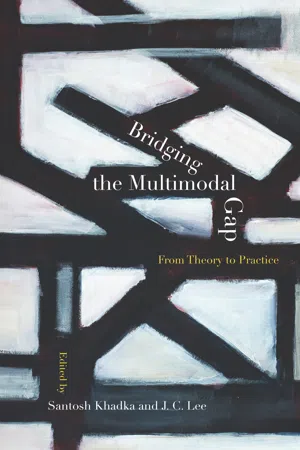
eBook - ePub
Bridging the Multimodal Gap
From Theory to Practice
- English
- ePUB (mobile friendly)
- Available on iOS & Android
eBook - ePub
Bridging the Multimodal Gap
From Theory to Practice
About this book
Bridging the Multimodal Gap addresses multimodality scholarship and its use in the composition classroom. Despite scholars' interest in their students' multiple literacies, multimodal composition is far from the norm in most writing classes. Essays explore how multimodality can be implemented in courses and narrow the gap between those who regularly engage in this instruction and those who are still considering its scholarly and pedagogical value.
After an introductory section reviewing the theory literature, chapters present research on implementing multimodal composition in diverse contexts. Contributors address starter subjects like using comics, blogs, or multimodal journals; more ambitious topics such as multimodal assignments in online instruction or digital story telling; and complex issues like assessment, transfer, and rhetorical awareness.
Bridging the Multimodal Gap translates theory into practice and will encourage teachers, including WPAs, TAs, and contingent faculty, to experiment with multiple modes of communication in their projects.
Contributors: Sara P. Alvarez, Steven Alvarez, Michael Baumann, Joel Bloch, Aaron Block, Jessie C. Borgman, Andrew Bourelle, Tiffany Bourelle, Kara Mae Brown, Jennifer J. Buckner, Angela Clark-Oates, Michelle Day, Susan DeRosa, Dànielle Nicole DeVoss, Stephen Ferruci, Layne M. P. Gordon, Bruce Horner, Matthew Irwin, Elizabeth Kleinfeld, Ashanka Kumari, Laura Sceniak Matravers, Jessica S. B. Newman, Mark Pedretti, Adam Perzynski, Breanne Potter, Caitlin E. Ray, Areti Sakellaris, Khirsten L. Scott, Rebecca Thorndike-Breeze, Jon Udelson, Shane A. Wood, Rick Wysocki, Kathleen Blake Yancey
After an introductory section reviewing the theory literature, chapters present research on implementing multimodal composition in diverse contexts. Contributors address starter subjects like using comics, blogs, or multimodal journals; more ambitious topics such as multimodal assignments in online instruction or digital story telling; and complex issues like assessment, transfer, and rhetorical awareness.
Bridging the Multimodal Gap translates theory into practice and will encourage teachers, including WPAs, TAs, and contingent faculty, to experiment with multiple modes of communication in their projects.
Contributors: Sara P. Alvarez, Steven Alvarez, Michael Baumann, Joel Bloch, Aaron Block, Jessie C. Borgman, Andrew Bourelle, Tiffany Bourelle, Kara Mae Brown, Jennifer J. Buckner, Angela Clark-Oates, Michelle Day, Susan DeRosa, Dànielle Nicole DeVoss, Stephen Ferruci, Layne M. P. Gordon, Bruce Horner, Matthew Irwin, Elizabeth Kleinfeld, Ashanka Kumari, Laura Sceniak Matravers, Jessica S. B. Newman, Mark Pedretti, Adam Perzynski, Breanne Potter, Caitlin E. Ray, Areti Sakellaris, Khirsten L. Scott, Rebecca Thorndike-Breeze, Jon Udelson, Shane A. Wood, Rick Wysocki, Kathleen Blake Yancey
Frequently asked questions
Yes, you can cancel anytime from the Subscription tab in your account settings on the Perlego website. Your subscription will stay active until the end of your current billing period. Learn how to cancel your subscription.
No, books cannot be downloaded as external files, such as PDFs, for use outside of Perlego. However, you can download books within the Perlego app for offline reading on mobile or tablet. Learn more here.
Perlego offers two plans: Essential and Complete
- Essential is ideal for learners and professionals who enjoy exploring a wide range of subjects. Access the Essential Library with 800,000+ trusted titles and best-sellers across business, personal growth, and the humanities. Includes unlimited reading time and Standard Read Aloud voice.
- Complete: Perfect for advanced learners and researchers needing full, unrestricted access. Unlock 1.4M+ books across hundreds of subjects, including academic and specialized titles. The Complete Plan also includes advanced features like Premium Read Aloud and Research Assistant.
We are an online textbook subscription service, where you can get access to an entire online library for less than the price of a single book per month. With over 1 million books across 1000+ topics, we’ve got you covered! Learn more here.
Look out for the read-aloud symbol on your next book to see if you can listen to it. The read-aloud tool reads text aloud for you, highlighting the text as it is being read. You can pause it, speed it up and slow it down. Learn more here.
Yes! You can use the Perlego app on both iOS or Android devices to read anytime, anywhere — even offline. Perfect for commutes or when you’re on the go.
Please note we cannot support devices running on iOS 13 and Android 7 or earlier. Learn more about using the app.
Please note we cannot support devices running on iOS 13 and Android 7 or earlier. Learn more about using the app.
Yes, you can access Bridging the Multimodal Gap by Santosh Khadka, J. C. Lee, Santosh Khadka,J. C. Lee in PDF and/or ePUB format, as well as other popular books in Languages & Linguistics & Creative Writing. We have over one million books available in our catalogue for you to explore.
Information
Index
accessibility, 9, 24, 30, 31, 37, 38, 40
affordance, 9, 18, 25, 35, 41, 81, 100, 138, 154, 158, 196, 201, 203, 206, 211, 245–250, 253, 255, 257–258, 260, 268–271, 275, 280
Alexander, Jonathan, 162, 203, 266
alphabetic, 3, 5, 21, 34, 44, 47, 53–54, 56, 70–75, 78–84, 89, 100, 141, 161, 201–202, 204–205, 207, 219, 221, 244–245, 247–250, 266, 268, 274, 276–278
analogy, 232, 237, 240–241, 275
analysis, 10, 19–21, 55, 60, 76–77, 83, 100, 115, 123, 130, 136, 144–147, 151, 153, 156, 164–166, 173, 186, 193, 198, 207–208, 211, 215–217, 219, 233, 251–252, 270–271, 274, 279
animation, 3, 44, 61, 75, 210–211, 213
application, 5, 9, 22, 36, 44, 158, 168, 179, 210, 212
archiving, 10, 107, 109, 111, 113...
Table of contents
- Cover
- Title Page
- Copyright Page
- Contents
- Introduction: Extending the Conversation: Theories, Pedagogies, and Practices of Multimodality
- Section I
- Section II
- Section III
- Section IV
- About the Authors
- Index